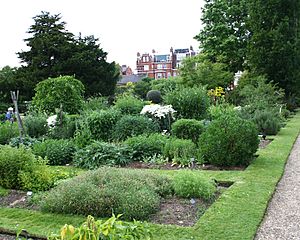Chelsea Physic Garden facts for kids
Quick facts for kids Chelsea Physic Garden |
|
|---|---|

Chelsea Physic Garden, London
|
|
| Location | Chelsea, London |
| Area | 3.5 acres (1.4 ha) |
| Created | 1673 |
| Founder | Worshipful Society of Apothecaries |
| Species | 5,000 |
The Chelsea Physic Garden is a special garden in London, England. It was started in 1673 by a group called the Worshipful Society of Apothecaries. They were like early pharmacists and doctors. Their goal was to grow plants that could be used as medicines.
This garden is called a "physic garden" because "physic" means the science of healing. It's one of the oldest botanical gardens in Britain. Only the University of Oxford Botanic Garden is older. The garden's rock garden is the oldest in Europe for alpine plants and plants from the Mediterranean.
The garden has tall brick walls that keep it warm inside. This creates a special warm climate. It even has the biggest olive tree in Britain that grows fruit. It also has the world's most northern grapefruit tree growing outside. For a long time, only the Apothecaries used the garden. But in 1983, it became a charity and opened to everyone.
The Chelsea Physic Garden is part of the London Museums of Health & Medicine. It is also a very important historical site. It is listed as Grade I in the Register of Historic Parks and Gardens of Special Historic Interest in England. This means it's a place of great historical interest.
Contents
History of the Chelsea Physic Garden
The Worshipful Society of Apothecaries first set up the garden in Chelsea, London. They leased the land from Sir John Danvers. This land was next to a house that used to belong to Sir Thomas More.
In 1713, a very important person named Sir Hans Sloane bought the land. He then leased it to the Society of Apothecaries in 1722. They paid only £5 a year! Sir Sloane asked them to send 50 plant samples each year to the Royal Society. This was a group of important scientists.
The Golden Age of the Garden
The garden became very famous under the leadership of Philip Miller. He was the head gardener from 1722 to 1770. During this time, it became one of the best botanical gardens in the world.
The garden started a seed-exchange program in 1682. This happened after a visit from Paul Hermann, a Dutch botanist. This program still runs today. One of its most famous achievements was bringing cotton plants to the colony of Georgia. More recently, it helped spread the Madagascar periwinkle plant around the world. This plant is used in medicine.
Elizabeth Blackwell drew many plants from the garden for her book, A Curious Herbal (1737–1739). Later, in 1781, many plant samples from the garden were given to the British Museum. Today, they are part of the Natural History Museum.
Sir Joseph Banks, a famous botanist, worked with the head gardener John Fairbairn. This was between 1780 and 1814. Fairbairn was very good at growing plants from all over the world.
Changes to the Garden's Size
Over the years, parts of the garden have been lost. Some land was used for road building. For example, a part was taken when the Chelsea Embankment was built in 1874. This was a road along the River Thames. Another strip was used to make Royal Hospital Road wider.
Today, the garden is about 3.5 acres (1.4 ha) in size. It is a peaceful green space in the middle of London.
Opening to the Public
In 1899, new managers took over the garden. For most of the 1900s, it was used mainly for science. It was not open to the public.
Then, in 1983, the garden became a charity. It was managed by a private group of trustees. A few years later, in 1987, it opened its doors to the general public for the first time.
In 2001, the director Rosie Atkins made changes to improve the garden's educational role. As of August 2025, Sarah Flannigan is the chair of the trust that manages the garden. Sue Medway MBE has been the garden director since 2014.
What You Can See Today
As of October 2017, the garden has about 5,000 different plants. They are organized into special areas, such as:
- The Garden of Medicinal Plants: This area has plants used for healing.
- The Pharmaceutical Garden: Here, plants are grouped by the illnesses they help treat.
- The Garden of World Medicine: This section shows medicinal plants used by different cultures around the world.
- The Garden of Edible and Useful Plants: This area features plants that people can eat or use in other ways.
- The World Woodland Garden: This part of the garden has plants that grow in woodlands around the globe.
Associated People
- William Aiton
- Johann Amman
- Alexander Anderson
- William Anderson (horticulturist)
- Joseph Banks
- John Bartram
- Elizabeth Blackwell
- Edward Augustus Bowles
- Mark Catesby
- Lilian Clarke
- William Curtis
- George Don
- Samuel Doody
- Henry Field (apothecary)
- William Forsyth
- Robert Fortune
- John Fraser
- John Graeffer
- William Houstoun
- William Hudson
- Jacob van Huysum
- Lee and Kennedy
- John Lindley
- Carl Linnaeus
- William Gregor MacKenzie
- Georg Christian Oeder
- Anthony du Gard Pasley
- Robert Petre, 8th Baron Petre
- James Sherard
- Hans Sloane
- Daniel Solander
- Mary Somerset
- Nathaniel Bagshaw Ward
See also
 In Spanish: Jardín Medicinal de Chelsea para niños
In Spanish: Jardín Medicinal de Chelsea para niños




